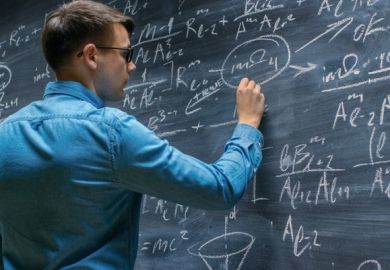John Stewart Bell died just over ten years ago, on October 1 1990, aged 62. Physicists were shocked and saddened by the sudden loss of a colleague whose work "had had the greatest impact on the interpretation of quantum mechanics of anyone since the 1920s". The quotation is from the contribution by Kurt Gottfried and David Mermin to this collection of nine essays edited by John Ellis and Daniele Amati to honour Bell's memory. The preface, "Biographical notes on John Bell", is written by his wife Mary, whom he married in 1954 and with whom he wrote several papers on the design of particle accelerators.
Few theorems in the history of mathematics and physics can be as widely acclaimed as Bell's theorem, which has to do with "hidden variables" in quantum mechanics and the nature of quantum non-locality. Bell was an unrelenting critic of the conventional formulation and interpretation of quantum mechanics. So it is natural that most of the essays centre on these themes. Nevertheless, Bell's work ranged much more widely, from the design of accelerators to the symmetries of fundamental interactions. These latter interests are evoked in an elegant essay by Jon Leinaas on "Quantum effects in accelerator physics", and in a moving tribute by Roman Jackiw, "Remembering John Bell". The rest of this review will, however, refer to the remaining seven essays, which in many ways provide a commentary on Bell's marvellous collection Speakable and Unspeakable in Quantum Mechanics (1987), which he called his "papers on quantum philosophy".
Does anyone understand quantum mechanics? Richard Feynman famously thought not, while acknowledging -like everyone else -that it was fantastically successful in practical terms. Bell too had great respect for the empirical success of quantum mechanics, but he believed passionately that (in the words of Gottfried and Mermin again) "a theory that merely succeeded in accounting brilliantly for data, without providing a satisfactory understanding of what it described, should be subject to stringent critical scrutiny, and if such an understanding was found to be unattainable, the theory should be expected to crumble". Such an attitude towards quantum mechanics in the 1960s was unfashionable, to say the least. Indeed, Bell and Michael Nauenberg wrote a paper in 1966 called "The moral aspect of quantum mechanics", in which they were led "inescapably to the conclusion that quantum mechanics is, at the best, incomplete". To this, they added the footnote: "This minority view is as old as quantum mechanics itself, so the new theory may be a long time coming... We emphasise not only that our view is that of a minority, but also that current interest in such questions is small. The typical physicist feels that they have long been answered, and that he will fully understand just how if ever he can spare 20 minutes to think about it".
The view that quantum mechanics was incomplete was, of course, most prominently held by Einstein. Together with Nathan Rosen and Boris Podolsky, he published a paper in 1935, referred to as EPR, in which it was argued that quantum mechanics could not be a complete theory, but should be supplemented by additional ("hidden") variables. The EPR paper was seen by Niels Bohr as a serious threat to the painfully constructed Copenhagen interpretation of quantum mechanics. Previous challenges by Einstein had often been posed in terms of hypothetical "thought experiments", and Bohr had always managed to refute them. But they had all referred to situations involving just one quantum particle. The new feature of the EPR paper was that it proposed a thought experiment involving two quantum particles, in a particular kind of correlated, or "entangled", state. In the EPR "experiment", the two particles -still carrying their correlation -were imagined to move apart. EPR argued that measurements performed on one particle would reveal information about the other's state that did not appear in the standard quantum-mechanical description. Thus the latter was incomplete.
Bohr's reply to EPR followed swiftly, in the next issue of The Physical Review (1935). In contrast to the beautifully simple mathematical formulation of EPR, Bohr's reply contained not a single equation, and its central riposte is, to this day, obscure. Nevertheless, such was Bohr's authority that people accepted that he had won, yet again. This view was reinforced by an apparently very general proof by John von Neumann in 1932, that any attempt to supplement the conventional theory with hidden variables of the type indicated by EPR must necessarily disagree with some of the theory's quantitative predictions.
Mary Bell recalls how, in the early 1950s, John had been "extremely stimulated" by David Bohm's papers on hidden variables, which provided a working counter-example to von Neumann's "non-existence" proof, since Bohm's theory perfectly reproduced the predictions of Schrodinger's quantum mechanics. The problem simmered in Bell's mind until, during a year at the Stanford Linear Accelerator in California (1963-64), he had time for reflection. This was the year out of which emerged the two papers that defined the subsequent course of foundational studies in quantum mechanics.
The first paper disposed of von Neumann's proof by pointing out that the hidden-variable theories he had excluded were required to satisfy a physically unjustifiable, in fact quite arbitrary, constraint. The Bohm theory was discussed, and it was noted how "in this theory an explicit causal mechanism exists whereby the disposition of one piece of apparatus affects the results obtained with a distant piece. In fact, the EPR paradox is resolved in the way which Einstein would have liked least... However, it must be stressed that, to the present writer's knowledge, there is no proof that any hidden variable account of quantum mechanics must have this extraordinary character." There followed a footnote stating that since the completion of the paper, such a proof had been found -and it (Bell's theorem) was duly published in the second paper, appearing in 1964.
Perhaps the most remarkable feature of that second paper was that it placed an issue that had seemed to be "interpretational" firmly in the experimental arena. Precise circumstances were delineated in which any "reasonable" hidden-variable theory (ie one without the extraordinary non-local character of Bohm's) would give predictions disagreeing with those of quantum mechanics: the EPR thought experiment had become a realisable one. One of those on whom this made a great impression was Alain Aspect, whose essay describes the series of remarkable experiments he and his collaborators have performed, and in which the predictions of quantum mechanics in EPR-type experiments were confirmed.
It seems that Bell had not expected a different outcome, though he thought it a pity that the "reasonable thing just doesn't work". In any case, the result did not affect his view that the theory carried "in itself the seeds of its own destruction" (the last words of the Bell-Nauenberg paper). What he found particularly offensive in conventional formulations was the reliance on measurement -a notion at once vaguely defined and external to the theory. Bell's last article, "Against measurement", analysed the treatment of this issue in two "good books". This collection contains an essay by the author of one of those books, Gottfried, which is a classic defence of his position. Not everyone accepts the defence, however. One of those who does not is Giancarlo Ghirardi, whose essay provides an authoritative review of theories that solve the perceived difficulties by modifying the Schrodinger equation, a programme Bell vigorously supported.
Bell's theorem was further developed by many physicists, among them Abner Shimony, who gives a masterly discussion of questions such as the curious "peaceful coexistence" between quantum mechanics and relativity, which seems to be implied by the impossibility of capitalising on EPR correlations to signal superluminally. He also shows how cases exist in which there is a contradiction between the EPR assumptions and non-statistical predictions of quantum mechanics (Bell's results referred to statistical correlations). Some of these cases are analysed in the first essay in this collection, a remarkable geometrical tour de force by Roger Penrose, in which he shows the relevance to one of them of an ornament in the Dutch artist M. C. Escher's lithograph Waterfall . A valuable review of neutron-interference experiments by Helmut Rauch completes the collection. Many of these raise in acute form how "the interpretation of quantum mechanics goes beyond human intuition in certain cases".
There is no doubt that the distinguished editors and contributors have produced a volume that every student of quantum mechanics will want to own, alongside Speakable and Unspeakable . In the ten years that have elapsed since Bell's death, the delicate filaments of quantum reality have been explored and exploited in the interlocking fields of quantum optics, quantum computing and quantum cryptography. No hint of crumbling has yet been found. No doubt, quantum mechanics remains deeply mysterious, but as Gottfried thoughtfully concludes, it would seem that the crisis perceived by Bell "has not yet been formulated with sufficient precision to facilitate the birth of great offspring".
After all, Newton himself had great difficulty in understanding how distant bodies could act on one another, and abandoned the attempt, asserting that "it is enough that gravity really exists, and acts according to the laws which we have explained". Perhaps we should be content with a similar response, as Bell put it: "As for the correlations, well, that's quantum mechanics." Or, could it be that a crisis barely mentioned in this volume - that concerning the difficult union of quantum mechanics and Einstein's theory of gravitation -will prove to be the decisive one?
Ian Aitchison is professor of physics, University of Oxford.
Quantum Reflections
Author - John Ellis and Daniele Amati
ISBN - 0 521 63008 8
Publisher - Cambridge University Press
Price - £30.00
Pages - 202
Register to continue
Why register?
- Registration is free and only takes a moment
- Once registered, you can read 3 articles a month
- Sign up for our newsletter
Subscribe
Or subscribe for unlimited access to:
- Unlimited access to news, views, insights & reviews
- Digital editions
- Digital access to THE’s university and college rankings analysis
Already registered or a current subscriber? Login


